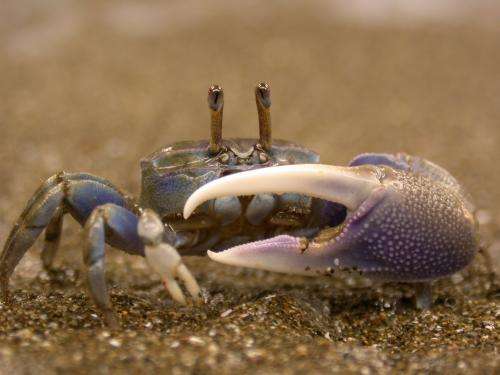Male fiddler crabs tread an evolutionary fine line between growing an enlarged claw better for signalling to females or one better for fighting finds research in BioMed Central's open access journal BMC Evolutionary Biology. Long light claws are better for attracting females, but not for fighting.
Fiddler crabs (Genus Uca), are sexually dimorphic – the males have one large and one small front claw while the females have two small claws. The males use their small claw for feeding and the large one to attract females for mating, threaten other males and as a weapon when fighting. As a flag the claw needs to be as large and light as possible so that it is easy to manoeuvre. As a weapon it needs to be heavy, with a thick cuticle, short pincers (dactyl and polex), and large muscle to close them.
Researchers from Gonzaga University and the Smithsonian Tropical Research Institute analyzed the morphology and mechanical properties of 21 species of fiddler crabs from the pacific, Gulf and Atlantic coasts of the Americas. Across the genus, different species have evolved a range of tactics. At the extremes U. argillicola has a small powerful claw but does not wave to attract females while U. heteropleura and U. saltitanta have weak claws but intense waving behaviours.
Dr Brook Swanson who led this study explained, "These crabs dramatically show the evolutionary trade-off driven by competing traits. The conflicting requirements of the claw for mate attraction and fighting may be the force driving and maintaining the diversity between species."
More information: Evolutionary variation in the mechanics of fiddler crab claws, Brook O Swanson, Matthew N George, Stuart P Anderson and John H Christy, BMC Evolutionary Biology 13:137 doi:10.1186/1471-2148-13-137
Journal information: BMC Evolutionary Biology
Provided by BioMed Central






















